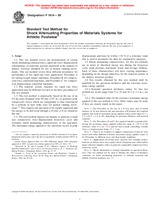Potrebujeme váš súhlas na využitie jednotlivých dát, aby sa vám okrem iného mohli ukazovať informácie týkajúce sa vašich záujmov. Súhlas udelíte kliknutím na tlačidlo „OK“.
ASTM F1614-99
Standard Test Method for Shock Attenuating Properties of Materials Systems for Athletic Footwear
Automaticky preložený názov:
Štandardná skúšobná metóda pre tlmiče poľahčujúcu vlastností materiálov systémy pre športovej obuvi
NORMA vydaná dňa 10.5.1999
Informácie o norme:
Označenie normy: ASTM F1614-99
Poznámka: NEPLATNÁ
Dátum vydania normy: 10.5.1999
Kód tovaru: NS-50929
Počet strán: 11
Približná hmotnosť: 33 g (0.07 libier)
Krajina: Americká technická norma
Kategória: Technické normy ASTM
Anotácia textu normy ASTM F1614-99 :
Keywords:
Carrier recombination lifetime, Contactless measurement, Free carrier density, Impurities-semiconductors, Microwave reflection, Photoconductivity decay, Recombination lifetime, Silicon semiconductors-slices/wafers, carrier recombination lifetime-silicon wafers, by noncontact measurement, of photoconductivity decay by microwave reflectance, test, ICS Number Code 61.060 (Footwear)
Doplňujúce informácie
| 1. Scope | ||||
|
1.1 This test method covers the measurement of certain shock attenuating characteristics, rapid rate force-displacement relationships, of materials systems employed in the midsole of athletic footwear intended for use in normal running movements. This test method covers three different procedures for performance of the rapid rate force application: Procedure A for falling weight impact machines, Procedure B for compression force controlled machines, and Procedure C for compression displacement controlled machines. 1.2 The material system response for rapid rate force application may be different for each of the three procedures of this test method. 1.3 This test method is empirically based on the use of an 8.5-kg mass dropped from 50 mm (1.97 in.) to generate peak compressive forces which are comparable to that experienced by a midsole in heel strike tests for normal running movement. This requires the specimen to be rigidly supported and the energy to be delivered through a 45-mm (1.8-in.) diameter flat tup. 1.4 This test method imposes an impulse to generate a rapid rate compressive force-displacement hysteresis cycle and evaluates shock attenuating characteristics of the specimen. The maximum energy applied to the specimen occurs at peak displacement and must be within +10% of a reference value that is used to normalize the data for comparative purposes. 1.5 Shock attenuating characteristics, for this test method, are in terms of absorbed energy loss during the hysteresis cycle, peak pressure, maximum strain, and average stiffness. Each of these characteristics will have varying importance, depending on the design objectives for the material system in the athletic footwear product. 1.6 Test results obtained by this test method shall be qualified by the specimen thickness and the reference maximum energy applied. 1.6.1 Nominal specimen thickness values for this test method are in the range from 5 to 35 mm (0.2 to 1.4 in.), see 7.1. 1.6.2 The standard value for the reference maximum energy applied of this test method is 5.0 J. Other values may be used, if they are clearly stated in the report. Note 1-For Procedure A, the use of a 8.5-kg mass and an initial distance of 50 mm between tup and specimen will produce the required impulse and result in maximum energy applied values in the range of 5 + 0.5 J (44.2 + 4.4 in.-lb), depending on specimen thickness and material response. Note 2-For Procedures B and C, the required impulse is produced by having the maximum energy applied within the range of +10% of the reference value (5 J, see 1.6.2) and the time to peak controlling variable (force or displacement) being 15 + 5 ms. Note 3-There is no evidence to support comparisons of data for tests which used either different reference maximum energy applied values or for Procedure A, different mass and drop height conditions. Note 4-Applications involving more vigorous (for example, basketball) use of athletic shoes may require shock absorption tests which utilize larger reference impulse values to generate comparable compressive force hysteresis cycles. Note 5-Shock attenuation is strongly dependent on specimen thickness. This test method can be used to identify the effects of thickness variations on shock attenuating properties of midsole materials and athletic footwear products, see 7.2. Note 6-Comparisons of different material systems by this test method should take careful consideration of prior impact conditioning. The ability of footwear materials to attenuate shock tends to decrease with repeated impact.1.7 The values stated in SI units are to be regarded as the standard. The inch-pound units given in parentheses are for information only. 1.8 This standard does not purport to address all of the safety concerns, if any, associated with its use. It is the responsibility of the user of this standard to establish appropriate safety and health practices and determine the applicability of regulatory limitations prior to use. |
||||
| 2. Referenced Documents | ||||
|




 Cookies
Cookies
